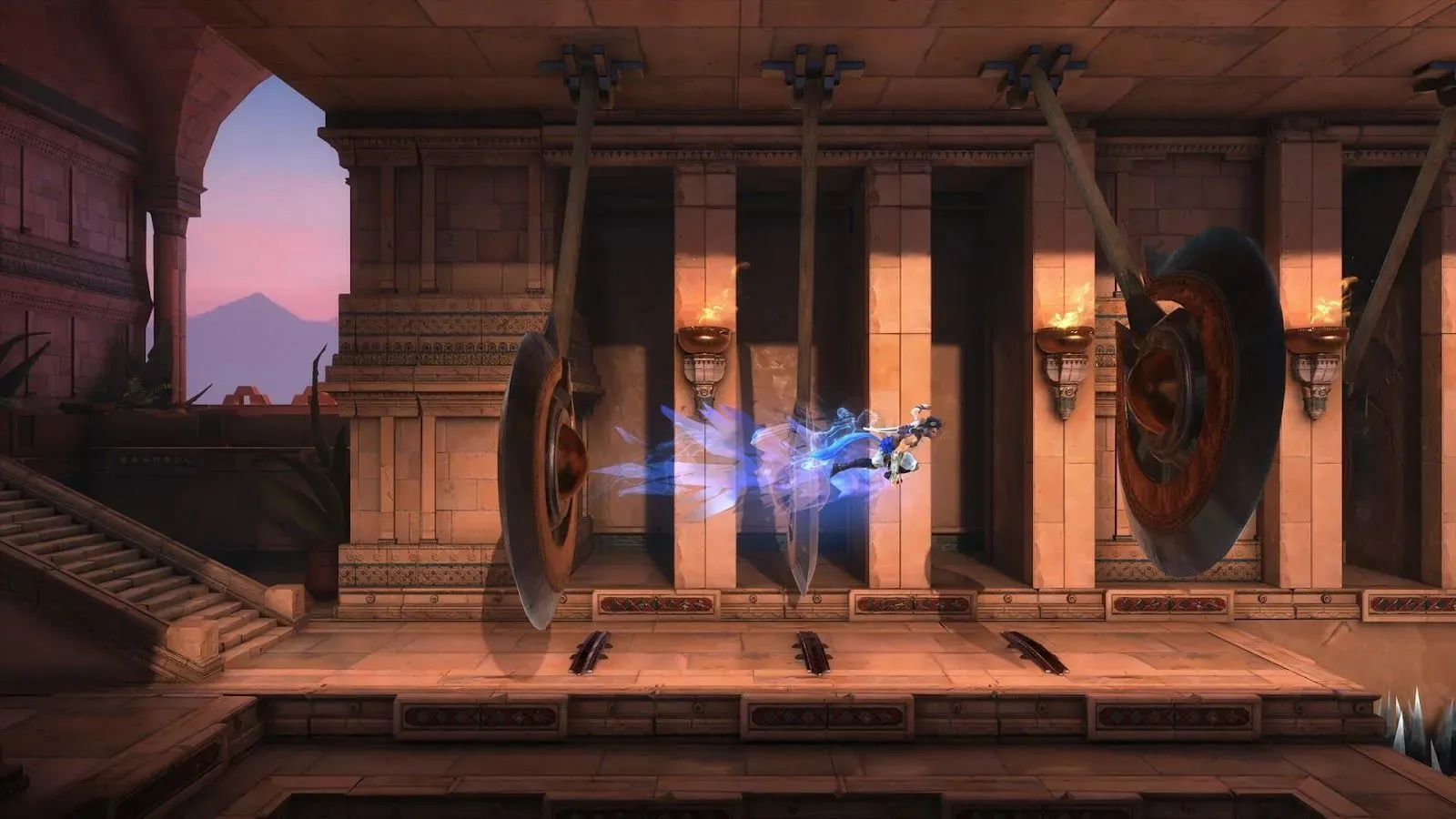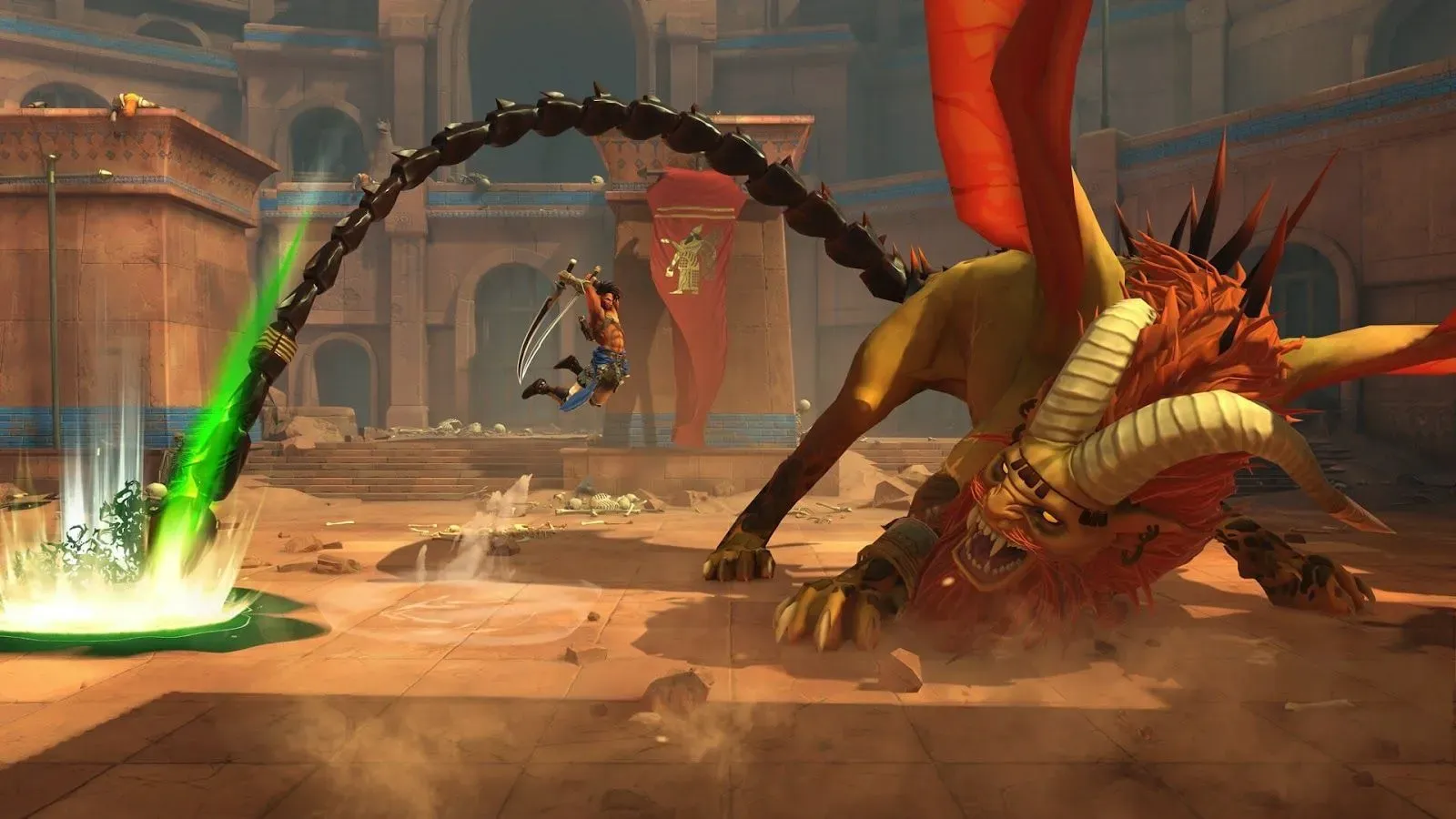PS5
PS4
Xbox One
Xbox Series
Switch
Playing this game made me wonder how Prince of Persia hadn’t always been a series of Metroidvanias. A slick 2D side-scroller, The Lost Crown arrives with both an understanding of the series’ past and a long list of present-day inspirations to make its own mark and usher in a promising new future for one of Ubisoft’s forgotten franchises.
An unexpected breath of fresh air, Prince of Persia: The Lost Crown is exactly what this series needed. Alongside the return to the 2D plane, Sargon and the other Immortals who protect Persia may initially be another potentially divisive break from tradition, especially for fans eagerly anticipating the next big Sands of Time-style adventure (or the classic game’s seemingly ill-fated remake). However, The Lost Crown eschews fan expectations across the board — not just of the series, but of the genre as well.
Although far from a complete reinvention, The Lost Crown looks to streamline the Metroidvania experience by offering players a solid challenge without being unnecessarily obtuse. Given that my typical experience with the genre starts with hopeful optimism, a chance that this might be “the one” to finally ‘click’, before ending abruptly with me frustrated at my own lack of know-how, this is a change I wholeheartedly welcome. The classic trope of discovering an inaccessible area early on and asking players to remember to come back later when they’ve unlocked the required ability is still very much at the core of the gameplay. However, the introduction of Memory Shards to mark places of interest on the map, complete with an accompanying screenshot, is something I have never seen before. No longer would I have to rely on my own hazy recollection of where something was; I had Memory Shards (albeit a finite amount) to guide my way.
It may not sound impressive on paper but, in practice, it was an absolute game-changer. Especially for the more absent-minded amongst us. Add to this the option to add objective markers in ‘Guided Mode’, its granular approach to difficulty levels, and its healthy accessibility options that allow players to skip entire complex platforming sections (amongst other potentially vital adjustments), it felt like the developers were doing as much as they could to make sure players of every ability could enjoy The Lost Crown in whatever way they chose to. Of course, if you’d prefer a more traditionally ruthless Prince of Persia experience, that option is also very much there for you too. I have neither the time nor the patience for that across the whole game, but I’d happily spend an hour trying my hand at a difficult optional platforming puzzle just for the sheer satisfaction.

The platforming is at the heart of everything in The Lost Crown. Every action has that glorious sticky friction feel to it that makes the gameplay that much more gratifying. Whether it’s simply hopping from platform to platform, leaping over an enemy before launching another attack or running and sliding through the world, the platforming in Prince of Persia: The Lost Crown scratches an itch that I didn’t know I even had. It made the “I’ll get it this time — one more run” nature of the game all the better, practically eradicating any real frustration because the gameplay was so good. Don’t get me wrong, nobody likes getting absolutely pasted by a boss. However, a quick respawn at a conveniently placed Wak-Wak Tree and I was back into the action ready to go again — either to rerun that fight or explore even more of Mount Qaf in search of a solution.
Overcoming the vastness of the mountain and the over-the-top encounters with mythical beasts and legendary warriors within is, of course, the key to your progress as you guide Sargon through Mount Qaf. These boss encounters started tame, albeit ridiculous in strength and scale throughout, but culminated in me needing to use all of my abilities, dexterity and cunning to come out the other side victorious. Each encounter felt like a satisfying combat puzzle with no two bosses ever feeling the same. One or two might have leaned a little on the cheap side for my liking but, with the right amount of thought, the powers at my disposal, and often the Amulets I had unlocked, the challenge was always set at the right level.
In place of a skill tree, Amulets allow you to add a limited amount of different augments to Sargon — extra health, additional damage, and the other kinds of unlockables that we’ve come to expect from games. Amulets (and additional Amulet slots) are unlocked through exploring the world and are just another example of The Lost Crown allowing players to forge their own path through the game. Balancing these Amulets and choosing the right build for a particular fight or task added another surprising layer of depth to the gameplay.

The Lost Crown’s (mostly) single-button combat is also deceptively simple, with a three-hit combo being Sargon’s go-to. However, combat can so often flow immediately into and out of traversal and sliding into a quick strike, dodging, striking again and then timing a perfect parry (resulting in a devastating killer blow) becomes par for the course after just a few hours with the game. These skills will come in handy when exploring too, with myriad monsters and mythical creatures rearing their ugly heads in every nook and cranny of the world. Sure, the vast majority of grunts can be dispatched with a few quick taps of the square button, but chaining attacks with dodges and slides and nailing that (pretty generous) parry window becomes increasingly necessary. Even writing that down, I’ve made it seem more complicated than my muscle memory remembers it. As someone who isn’t good with combos, I found combat easy to pick up but with a high ceiling when it came to attempting to master it.
That old school ‘easy to learn, hard to master’ mentality runs through every facet of Prince of Persia: The Lost Crown, just not in the way you may have come to expect. I hit a few brick walls during my time with the game, but rarely did I start a run or attempt a challenge and feel frustrated. However slow my progression felt at times, I always felt like I was moving forward or learning something new to help on the next run. That kind of positive reinforcement, however it’s achieved, is vital. Whether it was a boss fight, a tricky platforming section, or something else entirely it felt as if the game itself was rooting for me to succeed.
The gameplay really does do almost all of the heavy lifting when it comes to progression as well. Whilst it has its twists and turns and the occasional insightful character moment or a choice turn of phrase, the story of Prince of Persia: The Lost Crown is an otherwise by-the-numbers affair. Burdened with a poor first impression, the overall presentation of the story is told through motion-graphic cutscenes and, one or two characters aside, largely uninspiring voice acting. Would-be epic tales of Sargon’s building legend, the lore of The Immortals, the fate of Persia, and the curse that plagues Mount Qaf never matched the levels of polish that can be found in every facet of the gameplay. The lore items found in the environment go some way to help flesh out the world, detail characters and fill in the gaps, but the story feels like an afterthought of what is otherwise an almost flawless game.

The vastness of Mount Qaf tells its own story, however. As Sargon, I traversed through gilded palaces and festering sewers, haunting catacombs and even a galleon ship frozen in time — that last one being one of the most stunning levels I’ve experienced in a game in a long time. The game’s art style is vibrant and exciting. Colours pop and enemies all have a distinctive look and presence, but it never ventures into overly cartoonish territory. The sense of scale is incredibly impressive. Both enemies and architecture often dwarf Sargon, and there’s a real sense of awe in exploring this cursed monolith. Gradually connecting the dots throughout its ever-expanding map, and battling through one area only for it to throw me out in a place I’d first discovered hours earlier was always a triumphant and revelatory moment. Not just because of the destination, but because of the journey to get there.
Having conquered the mountain in just under 25 hours, albeit with more than a few side quests left incomplete, it’s plain to see that Ubisoft looked to modern classics like Dead Cells, Hades and Celeste when returning to Prince of Persia. However, it would be incredibly unfair to define The Lost Crown as borrowed genius. Much like Sargon himself, this is a game that has learned from the past and the present to hopefully carve out a vibrant new future for this beloved series.
You can subscribe to Jump Chat Roll on your favourite podcast players including:
Let us know in the comments if you enjoyed this podcast, and if there are any topics you'd like to hear us tackle in future episodes!




